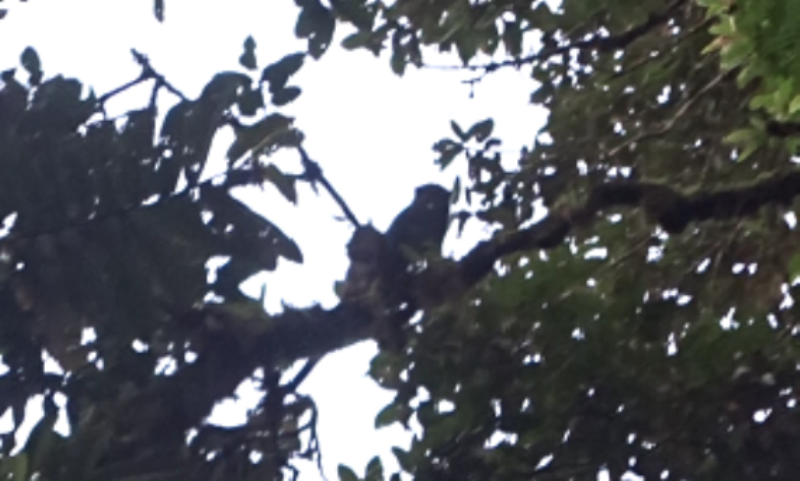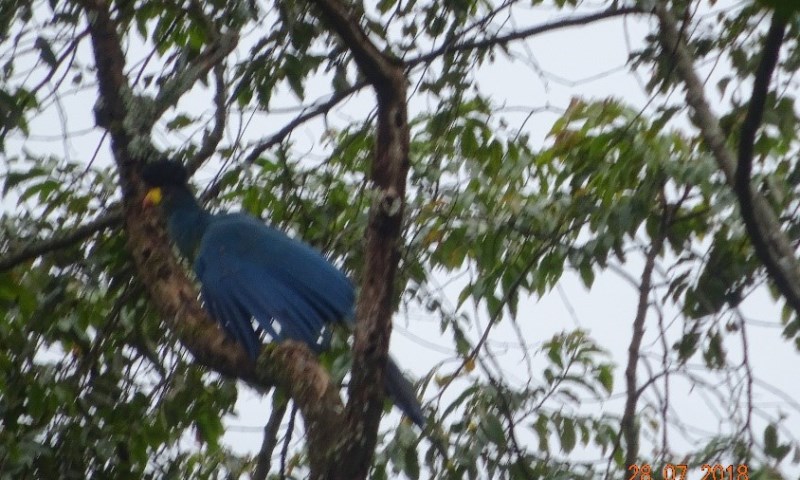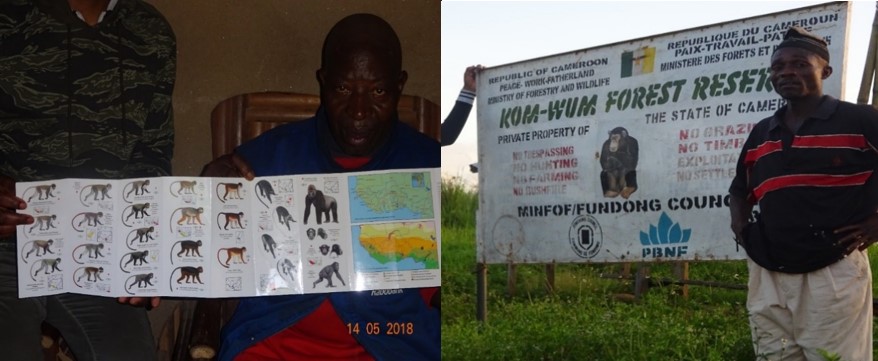Project update June 2023
Conservation awareness campaigns and livelihood improvement workshops in communities around the Kom-Wum Forest Reserve.
Pracond’s program manager travelled to Kom-Wum Forest Reserve on the 10th of May 2023. He organised conservation education and bee farming training workshops with hunters, farmers, children, and other Non-Timber Forest Products collectors of the Bu, Mbengkas, and Baiso village communities surrounding the reserve (Figure 1a-b). Additionally, in-depth discussions were held with the Fon of each village and with some key community members who have lived in the villages for more than ten years to improve conservation awareness (Figure 1c-d).

Figure 1: Conservation education workshops with children, farmers, and hunters of Mbengkas village (a&b), and awareness campaigns with the Fon of Mbengkas (c) and key community members of Bu village (d&e).
During the workshops, hunters and farmers were trained in constructing the Kenyan top bar beehives (Figure 2a&b). In total, 95 community members (22 hunters and 73 farmers) were trained on the new bee farming technique, which is not commonly practised by community members surrounding the Kom-Wum Forest Reserve. Ten hunters and 33 farmers were trained in Bu, eight hunters and 24 farmers in Mbengkas, and four hunters and 16 farmers in Baiso villages. Four bee suits and three smokers were offered to bee farmers to use as a group (Figure 2c). One chimpanzee conservation club (made up of mostly hunters) and a bee farmers association were created per village. The hunters were offered T-Shirts with alert messages to stop the hunting of chimpanzees and the consumption of bushmeat. One Community Initiative Group (CIG) was created per village consisting of hunters and bee farmers in the three selected villages. These CIG’S will be registered in the town of Wum before December 2023.

Figure 2: Pracond’s program manager trains hunters (a) and farmers (b) in constructing the Kenyan top bar beehive in Baiso and donates bee suites and smokers to bee farmers (c) and hunters (d) in Bu village.
Preliminary research findings in Kom-Wum Forest Reserve, North-West Region, Cameroon
The Nigeria-Cameroon chimpanzee (Pan troglodyte ellioti)
Population Size and Distribution: With fewer than 6000 individuals remaining in the wild and their distribution limited to Cameroon and Nigeria, this subspecies is indeed at risk. The fact that there are only about 83 individuals in the Kom Wum Forest Reserve is concerning, and the decreasing population trend emphasizes the urgency of conservation measures(Fotang et al.,2021).
Conservation Status: The International Union for Conservation of Nature (IUCN) has classified the Nigeria-Cameroon chimpanzee as Endangered. This designation underscores the critical need for conservation efforts to prevent further decline and potential extinction.
Legal Protection: The integrally protected status (Class A) in Cameroon is a positive step. This suggests that there are legal measures in place to safeguard this chimpanzee subspecies, but effective enforcement is crucial to ensure their survival.
Major Threats: The identified threats, including hunting, logging, extraction of non-timber forest products, and agricultural expansion, are common challenges faced by many wildlife species. Addressing these threats requires a multi-faceted approach, involving both conservation organizations and local communities.
Conservation Initiatives: It would be beneficial to know about any ongoing conservation initiatives or strategies in place to mitigate these threats and protect the Nigeria-Cameroon chimpanzee. This could include habitat restoration, anti-poaching efforts, community engagement, and educational programs.
Raising awareness about the plight of the Nigeria-Cameroon chimpanzee and garnering support for conservation efforts are crucial steps in ensuring the survival of this endangered subspecies.

The Nigeria-Cameroon chimpanzee in Kom-Wum Forest Reserve ©Fotang Chefor
The Olive baboon (Papio anubis)
The olive baboons are present in Kom-Wum Forest Reserve. The IUCN status is Least Concerned and is partially protected (Class C) in Cameroon.

Female baboon (Papio anubis) with a juvenile captured by wildlife cameras in Kom-Wum Forest Reserve ©Fotang Chefor.
Putty-nosed monkey(Cercopithecus nictitans ludio)
More than 14 groups of Putty-nosed monkeys have been seen in Kom-Wum Forest Reserve. On several occasions, they were found in a mixed group with Mona monkeys (Cercopithecus mona) and, on four events, with Nigeria-Cameroon chimpanzees.

Black-casqued wattled hornbill (Corythaeola cristata) and Great Blue Turaco (Corythaeola cristata)
The presence of the black-casqued wattled hornbill and great blue turaco has been confirmed in Kom-Wum Forest Reserve. Both species have been seen several times in the reserve.

Great Blue Turaco (Corythaeola cristata) in Kom Wum forest reserve ©Fotang Chefor. The IUCN status is Least concern and is partially protected (Class B) in Cameroon.

Female black-casqued wattled hornbill in Kom-Wum Forest Reserve©Fotang Chefor. The IUCN status is Vulnerable and partially protected in Cameroon (Class C).
Nesting ecology of chimpanzees in Kom-Wum Forest Reserve.
The Nigeria-Cameroon Cameroon builds both tree and ground nests in Kom-Wum Forest Reserve. PRACOND researchers also encountered ground day nests and tree day nests in reserve. More than ten ground nests night nests were recorded during PRACOND surveys in 2018, showing that the chimpanzees feel safe in this site compared to other reserves in Cameroon’s North-West Region.

Fresh ground nest(left) and tree nest (right) chimpanzee in Kom-Wum Forest Reserve ©Fotang Chefor.

PRACOND researcher measures the circumference of a nesting tree in Kom-Wum Forest Reserve(left). The principal investigator searches for hair in a chimpanzee ground nest in Kom -Wum Forest reserve (right).

A researcher measuring the slope under a nesting tree in Kom-Wum Forest Reserve (left). A researcher searching for chimpanzee hair in a tree nest in Kom -Wum Forest reserve (right).
Diet of Nigeria-Cameroon chimpanzee in Kom-Wum Forest Reserve
The chimpanzee of Kom-Wum Forest Reserve feed mostly on fruits. The figure below show chimpanzee dung dominated by fruit seeds.

Chimpanzee faeces encountered in Kom-Wum Forest Reserve dominated by fruit seeds©Fotang Chefor
Monitoring medium-to-large mammals wildlife species using camera trapping in Kom-Wum Forest Reserve

Pracond pro installing wildlife cameras with a community eco-guard( left) in Kom-Wum Forest Reserve ©Mvo Denis.
Conservation education, awareness programs, and sensitisation meetings on sustainable exploitation practices in local communities around Kom-Wum Forest Reserve

A researcher is investigating from a local community member which primate species are present in Kom-Wum Forest Reserve ©Mvo Denis.

